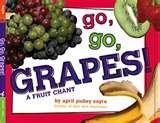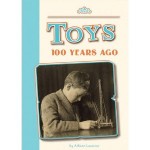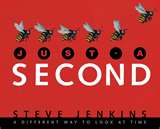Max’s Castle
 Let me make it easier for you this holiday season, because I know how it is. You want to buy a book for a child for the holidays, but you think they’d probably like a toy better, but you don’t want to give plastic junk, and yet do kids even like educational toys? Do you give the kid an abacus and watch that smile dissolve, or do you give in and buy a lead-coated choking hazard that promotes violence and unhealthy body images?
Let me make it easier for you this holiday season, because I know how it is. You want to buy a book for a child for the holidays, but you think they’d probably like a toy better, but you don’t want to give plastic junk, and yet do kids even like educational toys? Do you give the kid an abacus and watch that smile dissolve, or do you give in and buy a lead-coated choking hazard that promotes violence and unhealthy body images?
Get Max’s Castle written by Kate Banks and illustrated by Boris Kulikov along with wooden letter blocks, a game of Scrabble, or Bananagrams and everyone’s happy! If you have an iPad, tech it up for free by downloading the free Magnetic Letters app to play along while you read!
Max’s Castle is full of imagination and creative problem-solving, along with letter recognition and spelling. I love the way Banks and Kulikov show that switching a few letters changes words. Max and his brothers use alphabet blocks to build a castle. Kulikov does a fantastic job with letter arrangement: Max is in the MOAT hanging onto a block that is angled with an M and a B when Benjamin says they need a BOAT. The boys use the letter blocks to solve problems, like when the ADDER that is literally “in” the DARK DUNGEON (Banks capitalizes the words the boys have built with blocks) is causing problems, the boys take the L from the BUGLE to make the ADDER a LADDER.
Once you share Max’s Castle with that lucky kid or with your lucky students, give the kids letter blocks or Scrabble tiles or the iPad with the Magnetic Letters app to play with and rearrange! You can let students explore independently, or give challenges, like “Here comes a SNAKE ready to attack – what could you make to solve the problem?” Kids can switch out letters to make a RAKE to shoo away the snake, or TAKE it to the woods, or give it a SNACK to eat instead of eating you, etc. Encourage students to see if they can make the word look a bit like the object it represents, like Kulikov did, or use the blocks or tiles to build a structure like Max and his brothers did. Kids will build upon the Common Core State Standards of Print Concepts, Phonological Awareness, and Phonics and Word Recognition while they build fine motor skills. You’ll be the hero of the holidays!
Read MoreGo, Go, Grapes!
 Hip, hip, hooray for April Pulley Sayre and Go, Go, Grapes! A Fruit Chant! How do you make healthy eating fun? With Sayre’s vibrant photos of fruits taken at her local farmer’s market paired with her contagious rhymes:
Hip, hip, hooray for April Pulley Sayre and Go, Go, Grapes! A Fruit Chant! How do you make healthy eating fun? With Sayre’s vibrant photos of fruits taken at her local farmer’s market paired with her contagious rhymes:
“Nectarines, tangerines,
hit the spot.
Glum? Go plum.
Or apricot!”
Start your lesson by asking students, “What do you think a mangosteen is? Or a pomegranate?” Read Go, Go Grapes! and see if your kids can discover what those uncommon words mean. Reread the book and encourage kids to chime in (“Fruit is fun!”) Next, play “Cross the Line”: have all the kids stand on one side of the classroom and imagine an invisible line down the middle of the room – or put down tape if your maintenance team won’t go bananas. Say “Cross the line if you’ve tried kiwi,” and go through the fruits listed in the book. If you have time and funds, bring in some fruits for kids to try! (Check for fruit allergies first – some kids are allergic to certain berries.) Take photos of the fruits and have kids use those Logic Smarts to sort the photos – by color, or by which they liked and which they didn’t. With all the gorgeous colors of fresh produce, you can make a “color wheel” using fruits – challenge kids to eat a rainbow! Go, Go, Grapes, hooray for healthy eating, and super job, Ms. Sayre!
For more information, visit aprilsayre.com.
Read MoreToys 100 Years Ago
 It is only Day 3 of summer vacation, and already I’m hearing the words guaranteed to make a parent go bonkers: “I’m bored!” I point out the oodles of toys, many of them electronic and almost all of them plastic, that litter my house and yet, my child still insists that “there’s nothing to do”. Before I threaten my precious darling with a list of chores that could keep him occupied miserably for the next three months, I gently sit him down beside me to read this book.
It is only Day 3 of summer vacation, and already I’m hearing the words guaranteed to make a parent go bonkers: “I’m bored!” I point out the oodles of toys, many of them electronic and almost all of them plastic, that litter my house and yet, my child still insists that “there’s nothing to do”. Before I threaten my precious darling with a list of chores that could keep him occupied miserably for the next three months, I gently sit him down beside me to read this book.
Toys 100 Years Ago by Allison Lassieur is one of those wonderful nonfiction books that doesn’t read like a dry encyclopedia entry. The sepia photos of children from 100 years ago playing with Tinker Toys and Erector sets make me want to build something. Toys 100 Years Ago is an early reader book, so the words are simple enough for even young ones to understand. I love the section that talks about “homemade fun” and describes how kids used to make their own toys by cutting paper dolls, building model airplanes, and swinging on rope swings.
After reading this book, my child and I can discuss how it truly is possible to have fun without batteries, plastic, or electricity. In a classroom, I’d make a “Then and Now” chart with my students, and I’d share other books from the 100 Years Ago series, on topics like food, clothes, and school. At home or in the classroom, kids can use newspapers and magazines, popsicle sticks and crayons, string and clay to make their own kites, airplanes, dollhouses – anything they can imagine – just like the kids who, 100 years ago, dared to whine to their parents, “I’m bored!”
Read MoreJust a Second: a different way to look at time
 How many times do you think a hummingbird beats its wings in just one second? 10? 20? Steve Jenkins makes math irresistible in Just a Second: a different way to look at time. In one second, a hummingbird beats its wings 50 times. In one minute, a grizzly bear can charge one half-mile. Just a Second is full of information that fits well into units on time, measurement, and estimation, plus it’s visually captivating with Jenkins’ signature cut-paper art. His process in making the collages for his book is really cool, and you can see a video of how his books come together on his website: stevejenkinsbooks.com.
How many times do you think a hummingbird beats its wings in just one second? 10? 20? Steve Jenkins makes math irresistible in Just a Second: a different way to look at time. In one second, a hummingbird beats its wings 50 times. In one minute, a grizzly bear can charge one half-mile. Just a Second is full of information that fits well into units on time, measurement, and estimation, plus it’s visually captivating with Jenkins’ signature cut-paper art. His process in making the collages for his book is really cool, and you can see a video of how his books come together on his website: stevejenkinsbooks.com.
Before reading Just a Second, make some predictions with your students, like how many breaths do you think an adult takes in one hour? (900!) After reading the book and checking your predictions, make and test some new predictions about time. How many jumping jacks can you do in one minute? How long will it take you to flap your arms 50 times like a hummingbird? Can you sit perfectly still and quiet for a full minute? You can compare students’ results on charts or a graph. You can even make a pictograph of your classroom results, and let students make cool representations for themselves with cut-paper art. It may take a bit longer than “just a second”, but it will be time well spent.
Read More






